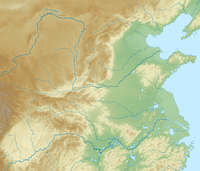
Back Batalla de Hulao Spanish Bataille de Hulao French Pertempuran Hulao ID 虎牢の戦い Japanese 호뢰 전투 Korean Slag bij Hulao Dutch Batalha de Hulao Portuguese Bitka kod Hulaoa Serbo-Croatian 虎牢之戰 Chinese
| Battle of Hulao | |||||||
|---|---|---|---|---|---|---|---|
| Part of the transition from Sui to Tang | |||||||
 Map of the Luoyang–Hulao campaign | |||||||
| |||||||
| Belligerents | |||||||
| Tang dynasty | Xia regime | ||||||
| Commanders and leaders | |||||||
| Li Shimin | Dou Jiande (POW) | ||||||
| Strength | |||||||
| Likely under 10,000 | 100,000–120,000 | ||||||
| Casualties and losses | |||||||
|
3,000 killed ~50,000 taken captive | |||||||
Location of the battle (Chinese Northern Plain) | |||||||
The Battle of Hulao, (Chinese: 虎牢之戰) or Battle of Sishui (汜水之戰, Wade–Giles: Ssŭ Shui),[2] was a decisive Tang victory over the rival Zheng and Hebei-based Xia polities during the transition from Sui to Tang. The battle took place during the Luoyang–Hulao campaign on 28 May 621 when a Xia army – led by Dou Jiande, ruler of Xia – was defeated attacking a smaller Tang army – led by Prince Li Shimin – entrenched at the strategic Hulao Pass.
Li launched the Luoyang–Hulao campaign in August 620, attacking eastwards and quickly besieging Wang Shichong, ruler of Zheng, in Luoyang. Zheng attempts to break the siege failed, and they appealed to Xia for help. In April 621, Dou led a Xia army of 100,000–120,000 troops westward to break the siege. Instead of retreating back to the Tang heartland in Shanxi, Li maintained the siege and took a small part of the Tang army further east to the Hulao Pass to block the Xia. A stalemate ensued for a few weeks; the Tang refused to fight outside of their positions, and the Xia refused to outflank Li or redirect their offensive to Shanxi.
Li broke the stalemate at the end of May by feinting the departure of a large part of the Tang cavalry. On the morning of 28 May, the Xia issued a challenge by arraying for battle in the open. The Tang sapped the endurance and unit cohesion of the waiting Xia by delaying the main action. A Tang cavalry probe at noon developed into a general attack as Xia cohesion collapsed. The Xia retreat, disrupted by poor communications and Tang cavalry in the rear and flanks, turned into a rout. The Xia defeat and Dou's capture led to the surrender of both Zheng and Xia to Tang. Tang emerged with control over the central plains, a dominant position from which it completed conquering China in 628.
- ^ Graff 2000, p. 83.
- ^ Fitzgerald 1933, p. 70.
© MMXXIII Rich X Search. We shall prevail. All rights reserved. Rich X Search
